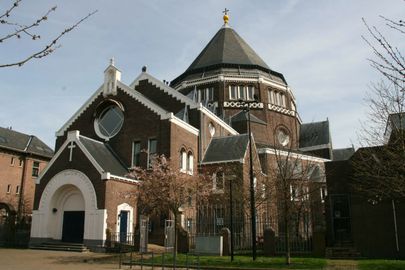

Under the umbrella dome of the Gerardus Majella Church, there had once been a greater complex consisting of a church, monastery and a number of schools most of which have by now been moved to other locations. In 1914 a temporary Catholic church was constructed at the corner of Sumatra Street and Borneo Street. The temporary church was dedicated to St. Gerardus Majella and by 1920 the parish counted about 3,500 people. The growing parish prompted an urgent need for a larger church. The architect Jan Stuyt was given the task of building a church on the Ambonplein square and, subsequently, designed an imposing dome in Byzantine style, partly inspired by the Hagia Sophia in Istanbul.
Initially, there was an intention to build a separate bell tower next to the church. The foundations had been laid, but lack of money resulted in abandoning this part of the plan. On December 8th, 1926 the church was inaugurated. During the celebratory procession, the priest, the altar boys and the faithful transposed the altarpiece and the sacred objects from the temporary church to the new building.
The parish flourished and the number of worshippers soon grew to 9,000 people. Other buildings included the Pastor Hesselveld School located next to the church, a parsonage, and a house for the sisters of St. Theresia that also served as an educational facility. As a result, a formidable Roman Catholic stronghold rose in the middle of the Indischebuurt.
The construction of the Majellakerk led to something of a church race for building the most beautiful and striking temple among the different factions. The Reformed did not want to be intimidated by the Catholics and erected their own churches and facilities. Recently, since over the past few decades many parishioners have left the area and moved to suburban Purmerend or Almere, the church has become far too big, the parish could no longer maintain the building which came to be destined for demolition. However, aware of its history, the neighborhood fathers wished to keep the building and the Zeeburg District Board supported their initiative. In 1992 the parish moved again, this time to a considerably smaller building on the Lombok Street.
In 2012, after a new renovation, the church acquired its current purpose as the home to the NedPho (Dutch Philharmonic Orchestra and the Dutch Chamber Orchestra). The NedPhO-Dome has since become a hospitable performance platform, which features monthly neighborhood concerts and special performances for children. For a fee of three Makkies, the residents can even get tickets for performances in the Concertgebouw. Launched in 2012, Makkie is the Indischebuurt community currency which is awarded to those who are actively involved in the community and which can be cashed in the local shops.
One sinister story connected with this church is a death that occurred here on Good Friday, March 29th 1929, when the roofer Leendert Arkenbout collapsed while working on the church's dome outside, fell to the ground and died on the spot. What some thought was an accident, was by others rumored to be murder. The employer of the roofer, a certain J.G. Maring, had apparently signed a 50,000 guilder life-insurance policy for his employee, and this amount was duly paid out to him in full. What raised serious suspicions of the insurance company was the fact that, immediately after the death of his employee, Maring wanted to take out a new insurance policy for the roofer’s successor.
Maring was soon arrested as a suspect but denied his guilt indignantly, while the body of Arkenbout was exhumed and sent for further investigation. The outcome of the latter revealed that Arkenbout's skull appeared to have been smashed with a hammer. Maring continued to deny his involvement and shifted the blame on the foreman W. H. Wessendorp. He did this by writing a note that asked witnesses to give false testimony against Wessendorp. He then hid the note inside a piece of bread and passed it on to a fellow detainee. However, the note was intercepted by an alert guard.
In addition to the note, other pieces of evidence had surfaced. Traces of Arkenbout's blood were found on the dome. The accused came up with a new declaration, which he said he had been too afraid to reveal before. Evidently, he had witnessed a fight between Arkenbout and Wessendorp, whereupon he saw the latter smash the former's head with a hammer, and was seriously threatened by the culprit that he would suffer the same fate if the truth came to light.
This resulted in the lawsuit dragging on further, as there was still no conclusive evidence and the suspect continued to vehemently deny his guilt. This went on until Maring made another serious blunder: in another intercepted note, he asked his son to shoot the witness Wessendorp and place a fake suicide note by his body. After presenting this piece of evidence, the public prosecutor demanded life sentence for Maring, a plea that was granted by the court. While being led away by the guards, the suspect cried in earnest, "Even if the court gives me a thousand years, I'm innocent!" Maring appealed to the Supreme Court but was still sentenced to life in prison. The case caused quite a commotion in the neighborhood and the denizens would reminisce about it for decades to come.